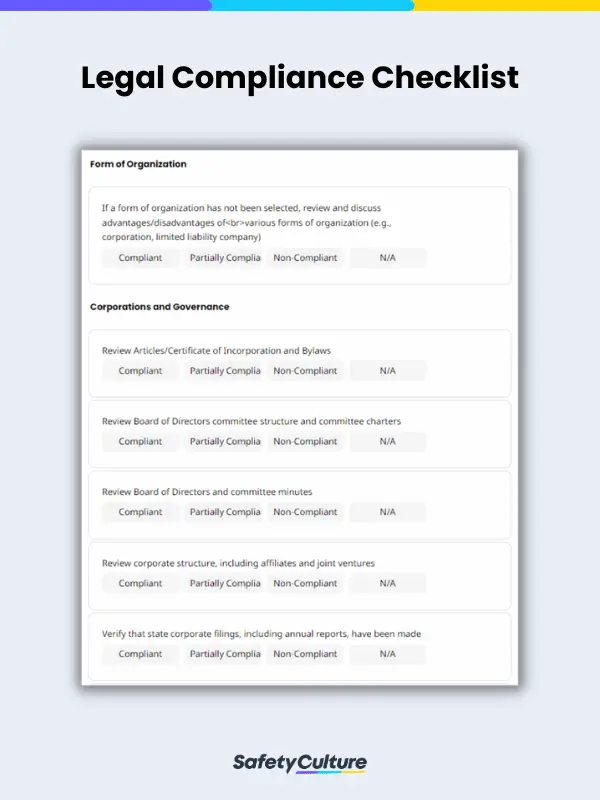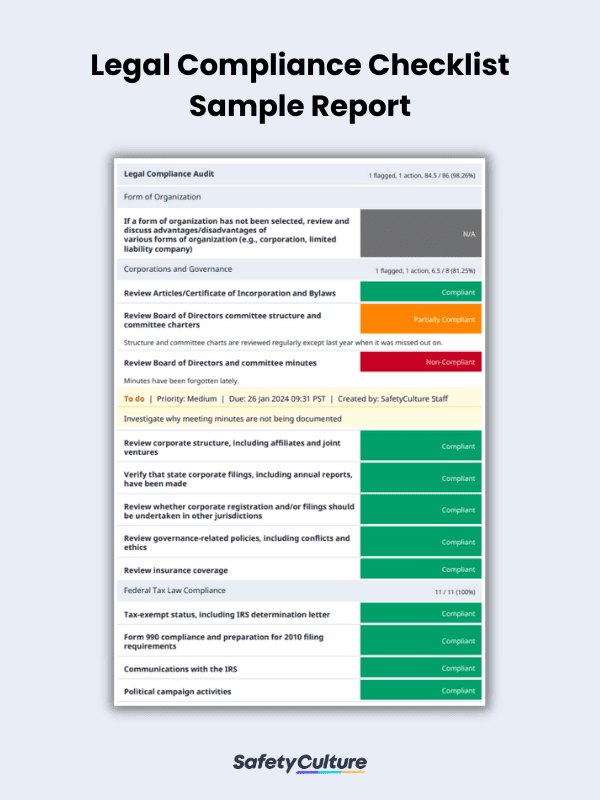What is a Legal Compliance Checklist?
A legal compliance checklist is a document used by companies, organizations, and managers to ensure all necessary laws and regulations are followed. In addition to adhering to laws, it also helps organizations with their company appraisals and audits.
Importance and Benefits
Legal compliance is an important aspect of managing a business, team, or organization. Generally, it refers to the adherence to laws, regulations, and standards relevant to a specific business or industry, ranging from labor and environmental laws to data protection regulations. The primary goal of legal compliance is to mitigate risks, protect stakeholders, and foster a culture of transparency within an organization.
In many cases, staying compliant with legal regulations requires many inspections, documentation, and paperwork, hence the need for a legal compliance checklist. A legal compliance checklist helps standardize processes to ensure all workers are on the same page, as well as assist inspectors, managers, and leaders in performing legal audits. Being non-compliant with laws and regulations can lead to fines, business closures, and more, which makes having a checklist all the more important.
Some benefits of using a legal compliance checklist, as stated by the American Bar Association and the Australian Government, include:
- Helping businesses more carefully examine their processes and practices
- Identifying possible risks to the company as well as risks for noncompliance
- Promoting safety by ensuring compliance with safety regulations
- Assessing current compliance programs to see if they are still relevant
- Helping businesses create new audit programs, if necessary
What to Include in a Legal Compliance Checklist
Each organization has different legal regulations they need to follow depending on the nature of their work, their industry, their auditing and compliance programs, and their location. However, a typical legal compliance checklist has fields for ensuring compliance with the following:
- Regular reviews of employees, leaders, and stakeholders
- Articles, documents, and internal standards
- Proper corporate structures and governance
- Financial standards and plans
- Reporting procedures
- Insurance coverages
- Tax payments and regulations
- Other standards set by the local government
- Intellectual property and trademark laws
- Document retention practices
- Internet and technology requirements
- Communications
- Human resources and employee benefits and culture
- Employee safety at work
- Contracts
- Lawsuits, if any
- Legal barriers, if any
Finish the legal compliance checklist with additional comments and recommendations, then a field for the signature of your auditor. These fields can give a deeper insight into your legal compliance as an organization and ensure that all aspects of your business have been properly analyzed.
Here is a sample legal compliance checklist in use for your reference:
Uses
Although a legal compliance checklist is often associated with complying with laws, it can also be used for the following purposes:
- Health and safety
- Data security and privacy
- General corporate governance
- Human resource management
FAQs about Legal Compliance Checklists
Upper management is usually in charge of managing legal compliance checklists for an organization. In some cases, it can specifically be handled by in-house legal teams and auditors, but sometimes, an organization may choose to use one created by a third party. However, it is still strongly recommended that each organization has its own legal compliance checklists.
The frequency of reviewing a legal compliance checklist depends on changes in laws and regulations, the nature of the business, and the level of risk involved. Typically, it is recommended to review and update the checklist on an annual basis or whenever significant legal changes that may impact the organization’s operations occur.
Most times, it is the organization’s legal department or legal counsel that conducts legal compliance checks. Sometimes, it can be a third-party auditor. However, general management, human resources, and relevant department heads may also be involved in the process.




